Trending
Opinion: How will Project 2025 impact game developers?
The Heritage Foundation's manifesto for the possible next administration could do great harm to many, including large portions of the game development community.
This article was originally posted on Black Shell Media's blog and discusses the 7 types of MMO Quests and how to implement them in your own games.

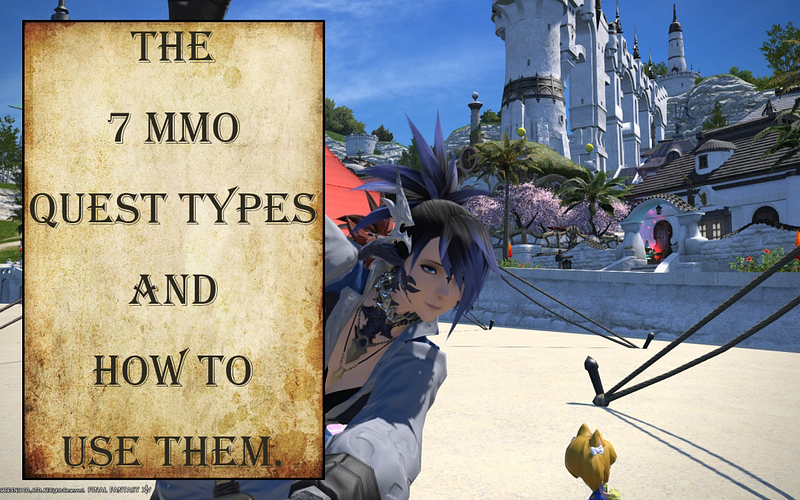
Recently, I started playing Final Fantasy XIV: A Realm Reborn after years of a personal grudge against Massively Multiple Online games. The quests of this game have made me realize how, over the years, the MMO genre has been changing. My MMO experience bounces between City of Heroes / City of Villains, World of Warcraft, DC Universe Online, Star Wars: Old Republic, and, now, Final Fantasy: A Realm Reborn. These games have inspired in me a new hope in the MMO genre that it will continue to evolve and improve, and I hope this discussion will encourage any MMO devs out there to push the envelope in terms of quest design.
In Massively Multiple Online Role Playing Games (MMORPGs), players level up by gaining experience. The most common way to gain experience is running around doing quests for NPCs. Quests are what MMO games use to tell the stories within their game. Every quest has a story, and it’s our job to stitch quests together to make cohesive stories from gameplay fragments.
Something worth noting is that quests themselves are not why people play MMO games. Quests are a necessity of the gameplay to get players into the parts they want to play. Whether it is story, gear, the PvP, or PvE, there is no reason for anything less than our full attention. Making the payoff feel rewarding is where the quests need the most attention. Players won’t feel justified having a game breaking piece of gear if they were required to slay a baby goblin. The rewards of these quests should match the difficulty players have when performing the task.
There are six major categories that quests fall into. These are all easily identifiable in any MMO game as well as games outside the genre — the difference being the story and how other genres have the luxury of being in a linear format. In an MMO the game, it isn’t just the story but the world it takes place in. Quests can be from a lost boy, a man lusting for a woman, or a guard tired of his job. The world an MMO takes place in needs to be alive, and a linear questline doesn’t usually do that. Beyond are the categories, a brief breakdown as well as things to look for when developing quests in MMO games.
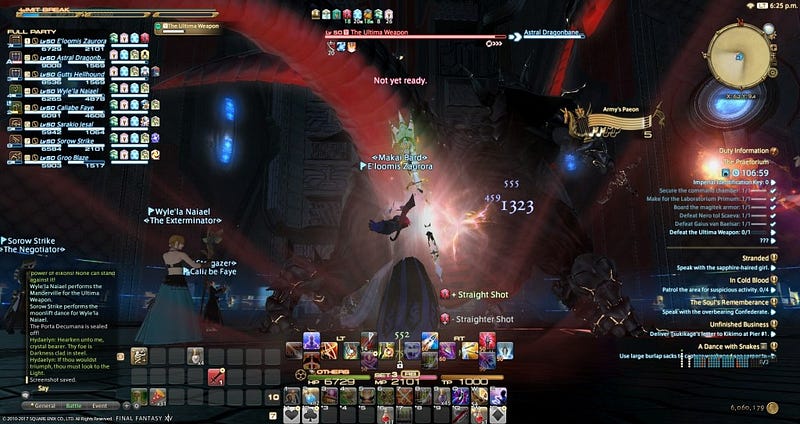
Fighting a Boss in Final Fantasy XIV — Stormblood expansion.
Kill quests are straight forward: find monsters in the region and kill them. Things that the designers should be aware of is the world they are building. How big is the region? Is the region split into smaller regions with unique enemies? The next thing to consider is the level of difficulty these enemies pose to the players. This comes with gauging where the players should be level-wise when they arrive to these types of quests. You wouldn’t want to send them to slay ten of a monster that they struggle to kill one of. Knowing the regions of the world and understanding the potential level requirements will keep these quests reasonable.
These are the bread and butter for any MMO, but it’s important to keep in mind that these types of quests aren’t even the memorable ones. Give kill quests to players early on when they arrive to a new area. By doing this, these quests reveal the new area to the player without them really being aware of it. It makes them look at the map for an area and/or how to get to it. These quests are also used as filler while doing other quests. Typically, quests overlap, and kill quests are the bulk of that overlap: they provide incremental achievements as you work toward the goals of more abstract quests. Regardless of the reasoning, these quests are great fun and give what most players are looking for: experience points and practice with the combat system!
Exactly as it sounds: your job is to follow this NPC to their destination, oftentimes protecting them along the way. The focus of these quests is never the player but instead an NPC. There are several parameters you can use when coding these types of missions. The most common parameters we see with escort missions are distance and health. An example of using distance is as simple as, “If the player is outside the range of X, then they fail”. Now, for health as a parameter it’s usually a failed mission if the NPC a player is escorting dies. Most missions that are set up with this parameter are forced into mandatory encounters for the player to fend off. Not all escort quests require an encounter though, maybe the issue is the time the player needs to fight against.
Now, these quests get the most groans, in my experience, as players don’t want to wait for an NPC. This can feel like the game is stealing control from them which can be a bad thing at times. If done right it can also lead players to new sections of maps they otherwise wouldn’t have ventured. The key to preventing escort quests from feeling like it stole from the player is to camouflage it with parameters. While players fight monsters attacking the NPC, have the NPC run around and work toward the destination still. In quests requiring that the player maintain a certain distance to the NPC, have some obstacles try to separate the player and NPC. Escort quests have a bad reputation because they only have one factor at play, making them repetitious and boring, so do everything in your power to make them worth playing!
These are vaguely similar to escort quests but in the hands of creative designers can feel incredibly unique in an of themselves. Where the escort quests choose to have the quest move in a direction, a defense quest is stationary. Using a defense quest is a great way to increase the tension of a scene in your game. If war is central to your game there is a great opportunity to have players defend the castle wall. The movie that perfectly depicts this scene is Lord of the Rings: Two Towers and the fight for Helm’s Deep. There isn’t much to these quest types, but again if done right can cement a great moment for your game.
The variables considered are nearly identical to the escort quests, but again there are a couple of differences. Both escort and defense types share the variables of health, but from there they differ. Instead of distance, defense quests utilize a wave variable. With this variable, you control the number and types of enemies set after their target. The most tension that a defense quest can create is from not knowing if the current wave is the last. To capitalize on this tension, or to signal to the player that it is the last, have a mini boss. It is important with these types of quests that the payoff is rewarding — do not be tricked by thinking a cool weapon is enough.
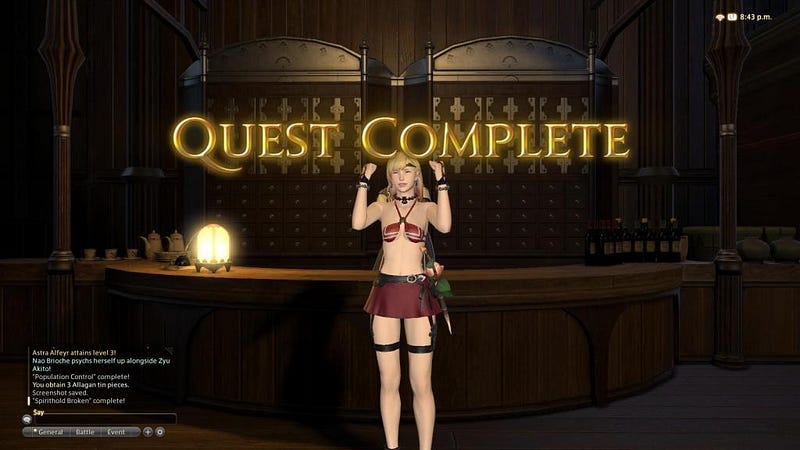
Picture from the Final Fantasy Fandom page
As adventurers, you’re the only ones “brave” enough to get things done, and because of this, townsfolk envy and fear you. They see who gets things done and who can help them with errands they can’t do themselves. The major part of gather quests are the areas they are given in. It would be inappropriate to have the player go fishing out in the desert in the middle of nowhere (unless you’re sand fishing, I suppose). Crafting is a great “story” reason for a player to need to go to an area to gather materials. Most MMOs today have crafting systems, and to level up your crafting skill, you’re required to gather materials to repurpose into items. Gather quests don’t always need to use the crafting mechanics, but it helps connect it to the players. Another idea could be to have an NPC craftsman ask the player to gather materials for them.
Gather quests are a common type of quest but are required to be given out in MMO games: if Destroy or Kill quests are your bread and butter, then Gather quests are your meat and potatoes. Somebody is always looking for something. It may not fall into the main storyline of your game, but it doesn’t have to. The request of the NPC should match a unique enemy or rare material to the section of the world they are in; again, unless there is an oasis in that desert, the players shouldn’t be given fishing quests, as it’s a little rude.
Not snow nor rain nor heat nor gloom of night will stop these players from delivering the goods. Running between lazy friends or merchants is the name of this game, and properly utilizing these quests are our task. Like other quests, we need to place these in our world carefully or risk breaking the immersion of the player. Factors to consider are where you send the player, size of the region, and remaining quests in the region. These are great for showing the player where the next area is and ‘hide’ that they don’t have a choice. Another great way to use these is to reveal a new city or new continent to the player.
Delivery quests also irritate players — maybe not as much as escort quests, but it still requires this warning. Utilize these quests by getting players familiar with large cities or moving the story from one area to the next. If the region doesn’t require a lot of quests, avoid these quests as they can break a player’s flow. Also, don’t have a gather quest and then a delivery quest to another NPC, instead, simply have them turn in the gather quest to the new NPC and lump them together. Not doing this can feel incredibly cheap like a waste of time to the player.
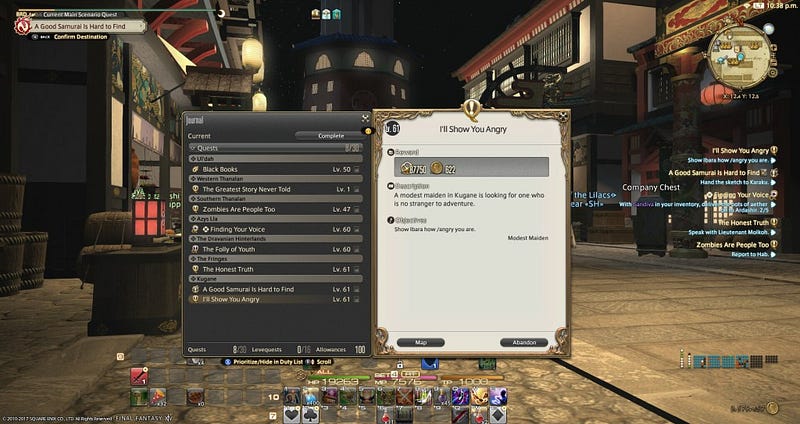
The Quest Log From Final Fantasy XIV — A Realm Reborn (Personal Screenshot)
There is no reason interacting with NPCs — or the game world for that matter — shouldn’t give the players experience points. The focus of these quests are the underutilized mechanics of emotes. Go to the ball and an NPC will teach a new style of /dance. Help an NPC play a trick on a friend by making the player /scare them. Go around to /water flowers because an NPC is sick and unable to themselves. The brilliance about using emotes in quests is that you are only limited by your imagination. Pick a location and explore the lore and use emotes to explain it through a quest. There is much to gain from using emotes as a method to interact with the world itself. After all, designers spend more time developing the worlds so why not display them in their best possible light?
This is great for breaking the monotony of run and kill things MMOs tend to have after a while. These are also a great quest type when introducing new events or expansion packs. The tradeoff is needing to code a large amount of emotes which takes more resources on the developer’s side. Something else to consider for these types of quests is the animations and rigging needing to happen to the models. These quests require more from the developers than others but also have a way to make your world incredibly immersive. If your team is onboard there is no reason you can’t develop emotes and utilize them for quests or rewards.
Let’s give an example of putting together a strong quest line. To start, a generalized fantasy aesthetic will be used for simplicity’s sake. Another note: this quest line will assume a mid-game point as to open our possibilities up. With all that out of the way, let’s do this!
First quest: NPC mentions how bandits have made camp in the nearby forest and wants the player to eliminate some. Second quest: Baker mentions the bandits have been preventing him from getting an ingredient for their famous pie, golden apples. Third quest: A bandit holds a letter announcing an attack on the nearby city, the city guard should see this. Fourth quest: The attack kicks off as the player shows the letter to the city guard.
This is a great start to a small area of our MMO game. We have a great spread of quest types and you can see how these already help our world feel immersive. Going through the quests you can also see how they line up to make a quest line. First the player will go to eliminate bandits in the forest and look for the rare golden apples. After looting some of the bandits, the player will find a letter that triggers quest three and the story continues. Arranging quests to work together is important as it helps keep our players on track for both story and level.
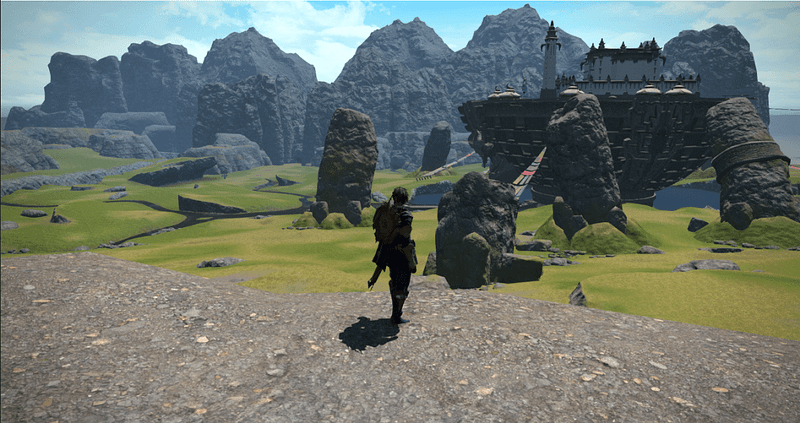
Screenshot from Final Fantasy XIV — A Realm Reborn
Now that we have fleshed out each of the quests, what does this mean? Well, we can officially discuss the major catalyst, story. Quests are only as effective as the story they tell. It doesn’t do your game any good if players rush through the reasoning for doing these quests. Story connects everything from main story or side quests and because of that, you can utilize this when weaving quests. The story of these quests doesn’t need to be to the immediate area. It is very common to have a quest that requires the player to travel to different locations of the map for a piece of the quest. Aspiring to make quests unique and memorable is a difficult but possible task.
The last piece of advice for designing your own quests would be placement, timing, and keeping them feeling fresh. Placing quests is also as important as knowing when to present them to the player. Giving quests to a player when it is clearly out of their current ability is dangerous. Roadblocking a player in this fashion can lead to them quitting the game entirely. On the flipside, sending a player back to a lower level areas dulls anything to do with the quest. When it comes to keeping these quests feeling fresh and new consider combining a couple of types together. An example of a good combination of types would be a kill and gather quest. Combining quests is a nice way to keep them feeling fresh, but not all combinations work together.
Again, these were six catchall categories for quests within the MMO genre and what to look for when designing them. Don’t agree with me? Is there another quest type that I missed? Have you seen a unique way quests are used in another game? Tell me in the comments section. I would love to discuss quests together!
~This article was originally posted on Black Shell Media’s Blog and can be found Here: http://blackshellmedia.com/2017/08/09/the-6-mmo-quest-types-and-how-they-work/ ~
Read more about:
BlogsYou May Also Like